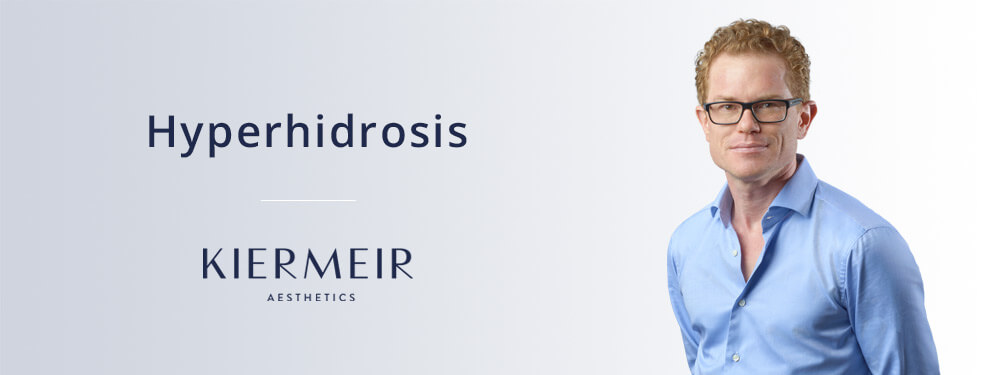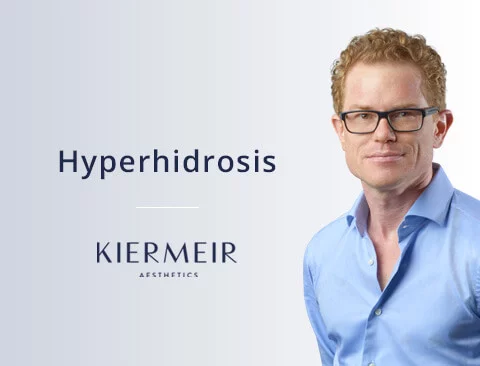Hyperhidrosis in Bern

Dr. med. David Kiermeir
Specialist for plastic, reconstructive and aesthetic surgery (FMH)
more than 15 years of surgical experience
since 12 years exclusively active in the field of plastic and aesthetic surgery
over 6,000 performed surgeries
Facts on Hyperhidrosis
| Treatment duration: | approx. 1 hour |
| Anaesthesia: | local or general anaesthetic |
| Hospital stay: | outpatient |
| Removal of sutures: | not necessary |
| Sports: | after a few weeks |
| Costs: | from CHF 700 |
The term hyperhidrosis denotes excessive, uncontrolled perspiration. Those affected suffer from constant outbreaks of sweat which occur without any specific cause and which often can’t be controlled with conventional deodorants. This often causes considerable psychological pain, as other people frequently regard profuse sweating as a sign of poor hygiene.
The causes of hyperhidrosis are yet to be fully uncovered. In common primary hyperhidrosis, it is thought that the cause lies in the autonomic nervous system. Secondary hyperhidrosis, on the other hand, denotes increased sweat production as a result of an illness or condition. There is a whole host of potential triggers, ranging from hormone imbalances to autoimmune disorders and high blood pressure.
Treatment options for hyperhidrosis
A variety of methods are available to treat hyperhidrosis, including both conservative therapies and surgical options. The most appropriate forms of therapy for your individual case will depend on the condition’s cause and severity. In hyperhidrosis caused by illness, the primary approach is to treat the underlying condition causing increased sweat production.
Hyperhidrosis can often be treated locally, such as by using aluminium chloride, substances containing tannic acid, Botulinumtoxin treatments or direct-current therapy. The aim of these treatments is either to block the sweat glands, normalise their function or disable the nerves in the affected areas. If the hyperhidrosis is not limited to a specific area, it can also be treated using antiperspirants or salvia extracts. In extreme cases, the option to surgically remove the sweat glands in the patient’s armpits could also be considered.
Before hyperhidrosis treatment
Before the hyperhidrosis treatment, Dr Kiermeir holds a personal consultation with the patient in Bern to determine the severity of their condition and discuss potential treatment methods. He then works to localise the affected areas. This is important, as it enables him to map out the affected locations precisely and choose an appropriate form of therapy to suit.
Most treatment methods are performed on an outpatient basis and don’t require any specific preparation. If any preparatory steps are necessary for your specific course of treatment, as is the case in sweat gland removal, Dr Kiermeir will explain these to you in your personal consultation.
The hyperhidrosis treatment procedure
Hyperhidrosis treatment is usually performed on an outpatient basis under local anaesthetic at our practice here in Bern. In isolated cases, surgical sweat gland removal can require general anaesthesia. The duration of treatment varies depending on the treatment method used.
In hyperhidrosis treatment with Botulinumtoxin, Dr Kiermeir injects the botulinum toxin directly into the skin in the affected areas. The effects of this treatment last for around six months, after which time they can be topped up. Iontophoresis, on the other hand, is a form of direct-current therapy with no additional substances or medications. Direct currents are applied to the affected areas through sponges or baths in order to alter sweat gland activity. This treatment is painless and can be repeated several times per week.
Surgical removal of sweat glands involves a similar procedure to liposuction. Dr Kiermeir uses fine cannulas to remove subcutaneous tissues while simultaneously detaching nerve supply to the sweat glands. The procedure takes around an hour and permanently reduces sweat production.
After hyperhidrosis treatment
Patients are usually able to leave our clinic in Bern as soon as the treatment is over. Inpatient stays are also only necessary in exceptional cases, even after surgical removal of sweat glands.
Following surgical sweat gland removal, a bandage is applied and must be worn for several days. You should also avoid sport and visits to the sauna and solarium for the first few weeks after treatment. You will be presentable as usual after around a week. Botulinumtoxin treatments, on the other hand, don’t require any recuperation periods.
Frequently asked questions on hyperhidrosis
As with all surgical procedures, treatment to remove sweat glands does entail a certain degree of risk. For instance, in rare cases patients develop infections, secondary haemorrhages, scarring or wound healing deficits. Furthermore, temporary sensory disturbances may occur in the areas treated.
All other forms of therapy are generally very low-risk. Botulinumtoxin treatments sometimes cause slight swelling or redness for a short period. Iontophoresis with tap water is a fundamentally harmless procedure, but must not be performed on certain groups of patients. These include, for instance, patients with pacemakers and pregnant women.
The results of surgical sweat gland removal are permanent. However, this method does not completely suppress sweat production, and instead only reduces it. The effects of a Botulinumtoxin treatment last for around six months. Iontophoresis with tap water is carried out over several weeks, after which time regular refresher treatments are also required as long-term therapy.
External substances such as aluminium chloride or tannic acid compounds are usually also applied over long periods, though in some cases with intervals between treatments.
CONTACT
Opening hours
| Monday | 8.00 a.m. - 5.00 p.m. |
| Tuesday | 8.00 a.m. - 5.00 p.m. |
| Wednesday | 8.00 a.m. - 5.00 p.m. |
| Thursday | 8.00 a.m. - 5.00 p.m. |
| Friday | 8.00 a.m. - 4.00 p.m. |
and by appointment



